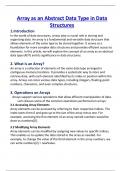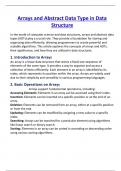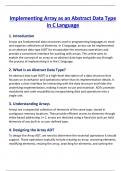6323
Dominican University Of California
All 9 results
Sort by

-
Time Complexity and Big O Notation
- Summary • 4 pages • 2023
-
- $7.99
- + learn more
In the world of computer science and programming, understanding the efficiency and performance of algorithms is crucial. Time complexity and Big O notation are two concepts that play a significant role in measuring the efficiency of algorithms and helping developers analyze their code. In this article, we will explore the intricacies of time complexity, delve into the principles of Big O notation, and understand their importance in optimizing code.

-
Array as an Abstract Data Type in Data Structures
- Summary • 5 pages • 2023
-
- $7.99
- + learn more
In the world of data structures, arrays play a crucial role in storing and organizing data. An array is a fundamental and versatile data structure that allows elements of the same type to be stored together. It serves as a foundation for more complex data structures and provides efficient access to elements. In this article, we will explore the concept of an array as an abstract data type (ADT) and its significance in data structures.

-
Arrays and Abstract Data Type in Data Structure
- Summary • 5 pages • 2023
-
Available in package deal
-
- $7.99
- + learn more
In the world of computer science and data structures, arrays and abstract data types (ADTs) play a crucial role. They provide a foundation for storing and organizing data efficiently, allowing programmers to create powerful and scalable algorithms. This article explores the concepts of arrays and ADTs, their significance, and how they are utilized in data structures.

-
Asymptotic Notations: Big O, Big Omega, and Big Theta Explained
- Summary • 4 pages • 2023
-
Available in package deal
-
- $7.99
- + learn more
In the world of computer science and algorithm analysis, understanding the efficiency and performance of algorithms is crucial. Asymptotic notations provide a standardized way to express and compare the growth rates of algorithms. Three commonly used asymptotic notations are Big O, Big Omega, and Big Theta. In this article, we will delve into the concepts of these notations and explore their significance in algorithmic analysis.

-
Best Case, Worst Case, and Average Case Analysis of an Algorithm
- Summary • 3 pages • 2023
-
Available in package deal
-
- $7.99
- + learn more
When analyzing algorithms, it is essential to consider their performance in different scenarios. This analysis helps us understand how an algorithm behaves under various conditions. The best case, worst case, and average case analyses are three common approaches used to evaluate the performance of algorithms. In this article, we will explore each of these analysis methods and their significance in algorithmic evaluation.

-
Coding Insertion Operation in Array in Data Structures in C language
- Summary • 4 pages • 2023
-
Available in package deal
-
- $7.99
- + learn more
In this article, we will delve into the coding implementation of the insertion operation in arrays using the C language. Arrays are an essential data structure that allows us to store a collection of elements of the same type in contiguous memory locations. Understanding how to perform insertion operations on arrays is crucial for building efficient algorithms. We will explore the process step by step, discussing the logic and code required for successful array insertion in C.

-
How to Calculate Time Complexity of an Algorithm
- Summary • 5 pages • 2023
-
Available in package deal
-
- $7.99
- + learn more
In the world of computer science and programming, analyzing the efficiency of an algorithm is crucial. Time complexity is a measure of how much time an algorithm takes to solve a problem as its input size increases. Understanding time complexity helps programmers optimize their code and make informed decisions about algorithm selection. In this article, we will explore various techniques to calculate the time complexity of an algorithm.

-
Implementing Array as an Abstract Data Type in C Language
- Summary • 4 pages • 2023
-
Available in package deal
-
- $7.99
- + learn more
Arrays are fundamental data structures used in programming languages to store and organize collections of elements. In C language, arrays can be implemented as an abstract data type (ADT) to encapsulate the necessary operations and provide a convenient interface for working with arrays. This article aims to explain the concept of an array as an abstract data type and guide you through the process of implementing it in the C language.

-
Operations on Arrays in Data Structures: Traversal, Insertion, Deletion, and Searching
- Summary • 5 pages • 2023
-
Available in package deal
-
- $10.39
- + learn more
Arrays are fundamental data structures that store a collection of elements in a contiguous block of memory. They provide efficient access to elements based on their indices and offer various operations for manipulating the data they hold. In this article, we will explore the common operations performed on arrays, including traversal, insertion, deletion, and searching. By understanding these operations, you will gain valuable insights into effectively working with arrays in data structures.

Did you know that on average a seller on Stuvia earns $82 per month selling study resources? Hmm, hint, hint. Discover all about earning on Stuvia


